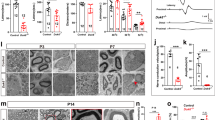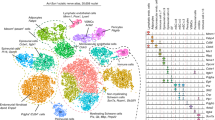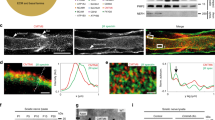Abstract
Transcription of the 2.5 megabase dystrophin gene gives rise to multiple isoforms. We describe a 5.2 kilobase transcript, expressed specifically in peripheral nerve, that initiates at a previously unrecognized exon located ∼850 basepairs upstream of dystrophin exon 56. The likely product of this transcript (Dp116) is detected by C–terminal dystrophin antibodies exclusively in peripheral nerve and cultured Schwann cells. Dp116 is located along the Schwann cell membrane but is not present in the compact myelin lamellae or in axons. Dp116 lacks actin–binding and spectrin–like rod domains, arguing that it functions differently in the Schwann cell than does the major dystrophin transcript in muscle.
This is a preview of subscription content, access via your institution
Access options
Subscribe to this journal
Receive 12 print issues and online access
$209.00 per year
only $17.42 per issue
Buy this article
- Purchase on Springer Link
- Instant access to full article PDF
Prices may be subject to local taxes which are calculated during checkout
Similar content being viewed by others
References
Monaco, A.P. & Kunkel, L.M. Cloning of the Duchene/Becker muscular dystrophy locus. Adv. hum. Genet. 17, 61–98 (1988).
Worton, R.G. & Thompson, M.W. Genetics of Duchenne muscular dystrophy. Ann. Rev. Genet. 22, 601–629 (1988).
Bar, S. et al. A novel product of the Duchenne muscular dystrophy gene which greatly differs from the known isoforms in its structure and tissue distribution. Biochem. J. 272, 557–560 (1990).
Lederfein, D. et al. A 71-Kilodalton protein is a major product of the Duchenne muscular dystrophy gene in brain and other nonmuscle tissues. Proc. natn. Acad. Sci. U.S.A. 89, 5346–5350 (1992).
Blake, D.J. et al. Characterization of a 4.8kb transcript from the Duchenne muscular dystrophy locus expressed in Schwannoma cells. Hum. molec. Genet. 1, 103–109 (1992).
Hugnot, J.P. et al. Distal transcript of the dystrophin gene initiated from an alternative first exon and encoding a 75-kDa protein widely distributed in nonmuscle tissues. Proc. natn. Acad. Sci. U.S.A. 89, 7506–7510 (1992).
Feener, C.A., Koenig, M. & Kunkel, L.M. Alternative splicing of human dystrophin mRNA generates isoforms at the carboxy terminus. Nature 338, 509–511 (1989).
Nudel, U. et al. Duchenne muscular dystrophy gene product is not identical in muscle and brain. Nature 337, 76–78 (1989).
Chelly, J. et al. Dystrophin gene transcribed from different promoters in neuronal and glial cells. Nature 344, 64–65 (1990).
Klamut, H.J., Gangopadhyay, S.B., Worton, R.G. & Ray, P.N. Molecular and functional analysis of the muscle-specific promoter region of the Duchenne muscular dystrophy gene. Molec. cell. Biol. 10, 193–205 (1990).
Rapaport, D. et al. Characterization and cell type distribution of a novel, major transcript of the Duchenne Muscular Dystrophy gene. Differentiation 49, 187–193 (1992).
Gorecki, D.C. et al. Expression of four alternative dystrophin transcripts in brain regions regulated by different promoters. Hum. molec. Genet. 1, 505–510 (1992).
Chelly, J., Kaplan, J.C., Maire, P., Gautron, S. & Kahn, A. Transcription of the dystrophin gene in human muscle and non-muscle tissue. Nature 333, 858–860 (1988).
Samitt, C.E. & Bonilla, E. Immunocytochemical study of dystrophin at the myotendinous junction. Muscle Nerve 13, 493–500 (1990).
Miike, T., Miyatake, M., Zhao, J., Yoshioka, K. & Uchino, M. Immunohistochemical dystrophin reaction in synaptic regions. Brain Dev. 11, 344–346 (1989).
Shimizu, T., Matsumura, K., Sunada, Y. & Mannen, T. Dense immunostainings on both neuromuscular and myotendon junctions with an anti-dystrophin monoclonal antibody. Biomed. Res. 10, 405–409 (1989).
Lidov, H.G.W., Byers, T.J., Watkins, S.C. & Kunkel, L.M. Localization of dystrophin to postsynaptic regions of central nervous system cortical neurons. Nature 348, 725–728 (1990).
Miyatake, M. et al. Dystrophin: localization and presumed function. Muscle Nerve 14, 113–119 (1991).
Byers, T.J., Kunkel, L.M. & Watkins, S.C. The subcellular distribution of dystrophin in mouse skeletal, cardiac, and smooth muscle. J. cell Biol. 115, 411–421 (1991).
Hoffman, E.P., Hudecki, M.S., Rosenberg, P.A., Pollina, C.M. & Kunkel, L.M. Cell and fiber-type distribution of dystrophin. Neuron 1, 411–420 (1988).
Koenig, M. et al. Complete cloning of the Duchenne muscular dystrophy(DMD) cDNA and preliminary genomic organization of the DMD gene in normal and affected individuals. Cell 50, 509–517 (1987).
Koenig, M., Monaco, A.P. & Kunkel, L.M. The complete sequence of dystrophin predicts a rod-shaped cytoskeletal protein. Cell 53, 219–226 (1988).
Koenig, M. et al. The molecular basis for Duchenne versus Becker muscular dystrophy: Correlation of severity with type of deletion. Am. J. hum. Genet. 45, 498–506 (1989).
Monaco, A.P., Bertelson, C.J., Colletti Feener, C. & Kunkel, L.M. Localization and cloning of Xp21 deletion breakpoints involved in muscular dystrophy. Hum. Genet. 75, 221–227 (1987).
Mount, S.M. A catalogue of splice junction sequences. Nucl. Acids Res. 10, 459–472 (1983).
Sicinski, P. et al. The molecular basis of muscular dystrophy in the mdx mouse: a point mutation. Science 244, 1578–1580 (1989).
Bennett, V. Spectrin-based membrane skeleton: a multipotential adaptor between plasma membrane and cytoplasm. Physiol. Rev. 70, 1029–1065 (1990).
Ervasti, J.M. & Campbell, K.P. Membrane organization of the dystrophin-glycoprotein complex. Cell 66, 1121–1131 (1991).
Suzuki, A., Yoshida, M., Yamamoto, H. & Ozawa, E. Glycoprotein-binding site of dystrophin is confined to the cysteine-rich domain and the first half of the carboxy-terminal domain. FEBS Lett. 308, 154–160 (1992).
Ibraghimov-Beskrovnaya, O. et al. Primary structure of dystrophin-associated glycoproteins linking dystrophin to the extracellular matrix. Nature 355, 696–702 (1992).
Arahata, K. et al. Preservation of the C-terminus of dystrophin molecule in the skeletal muscle from Becker muscular dystrophy. J. neurol. Sci. 101, 148–156 (1991).
Hoffman, E.P. et al. Is the carboxyl-terminus of dystrophin required for membrane association? A novel, severe case of Duchenne muscular dystrophy. Ann. Neurol. 30, 605–610 (1991).
Helliwell, T.R., Ellis, J.M., Mountford, R.C., Appleton, R.E. & Morris, G.E. A truncated dystrophin lacking the C-terminal domain is localized at the muscle membrane. Am. J. hum. Genet. 50, 508–514 (1992).
Recan, D. et al. Are cysteine-rich and COOH-terminal domains of dystrophin critical for sarcolemmal localization? J. clin. Invest. 89, 712–716 (1992).
Loh, E.Y., Elliott, J.F., Cwirla, S., Lanier, L.L. & Davis, M. Polymerase chain reaction with single-sided specificity: Analysis of T cell receptor delta chain. Science 243, 217–220 (1989).
Monaco, A.P. et al. Isolation of candidate cDNAs for portions of the Duchenne muscular dystrophy gene. Nature 323, 646–650 (1986).
Byers, T.J., Neumann, P.E., Beggs, A.H. & Kunkel, L.M. ELISA quantitation of dystrophin for the diagnosis of Duchenne and Becker muscular dystrophies. Neurology 42, 570–576 (1992).
Coffey, A.J. et al. Construction of a 2.6-Mb contig in yeast artificial chromosomes spanning the human dystrophin gene using an STS-based approach. Genomics 12, 474–484 (1992).
Roberts, R.G., Coffey, A.J., Bobrow, M. & Bentley, D.R. Determination of the exon structure of the distal portion of the dystrophin gene by vectorette PCR. Genomics 13, 942–950 (1992).
Koenig, M. & Kunkel, L.M. Detailed analysis of the repeat domain of dystrophin reveals four potential hinge segments that may confer flexibility. J. biol. Chem. 265, 4560–4566 (1990).
Hemmings, L., Kuhlman, P.A. & Critchley, D.R. Analysis of the actin-binding domain of alpha-actinin by mutagenesis and demonstration that dystrophin contains a functionally homologous domain. J. cell Biol. 116, 1369–1380 (1992).
Scott, M.O. et al. Duchenne muscular dystrophy gene expression in normal and diseased human muscle. Science 239, 1418–1420 (1988).
Author information
Authors and Affiliations
Rights and permissions
About this article
Cite this article
Byers, T., Lidov, H. & Kunkel, L. An alternative dystrophin transcript specific to peripheral nerve. Nat Genet 4, 77–81 (1993). https://doi.org/10.1038/ng0593-77
Received:
Accepted:
Issue Date:
DOI: https://doi.org/10.1038/ng0593-77
This article is cited by
-
Specific Dystrophins Selectively Associate with Inhibitory and Excitatory Synapses of the Mouse Cerebellum and their Loss Alters Expression of P2X7 Purinoceptors and Pro-Inflammatory Mediators
Cellular and Molecular Neurobiology (2022)
-
Duchenne muscular dystrophy
Nature Reviews Disease Primers (2021)
-
Cellular pathology of the human heart in Duchenne muscular dystrophy (DMD): lessons learned from in vitro modeling
Pflügers Archiv - European Journal of Physiology (2021)
-
Emerging Strategies in the Treatment of Duchenne Muscular Dystrophy
Neurotherapeutics (2018)
-
Timing and localization of human dystrophin isoform expression provide insights into the cognitive phenotype of Duchenne muscular dystrophy
Scientific Reports (2017)



